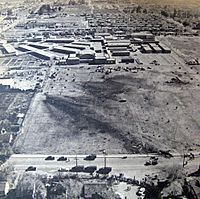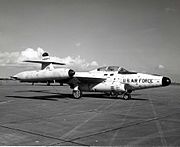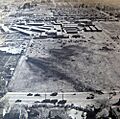1957 Pacoima mid-air collision facts for kids

Crash site
|
|
| Accident summary | |
|---|---|
| Date | January 31, 1957 |
| Summary | Mid-air collision |
| Place | Over the San Fernando Valley, California, United States 34°15′03″N 118°25′35″W / 34.25083°N 118.42639°W |
| Total injuries (non-fatal) | 78 (estimated) |
| Total fatalities | 8 |
| First aircraft | |
 Continental's second N8210H, also a DC-7B similar to the accident aircraft and delivered a few months after the incident |
|
| Type | Douglas DC-7B |
| Airline/user | Douglas Aircraft Company |
| Registration | N8210H |
| Flew from | Santa Monica Airport, Santa Monica, California, United States |
| Flying to | Santa Monica Airport, Santa Monica, California, United States |
| Passengers | 0 |
| Crew | 4 |
| Injuries (non-fatal) | 0 |
| Fatalities | 4 |
| Survivors | 0 |
| Second aircraft | |
 A Northrop F-89J Scorpion of the Wisconsin Air National Guard's 176th Fighter Interceptor Squadron in October 1972. |
|
| Type | Northrop F-89J Scorpion |
| Airline/user | United States Air Force |
| Registration | 52-1870 |
| Flew from | Palmdale, California, United States |
| Flying to | Palmdale, California, United States |
| Passengers | 0 |
| Crew | 2 |
| Injuries (non-fatal) | 1 |
| Fatalities | 1 |
| Survivors | 1 |
On January 31, 1957, a Douglas DC-7B airplane, operated by the Douglas Aircraft Company, was involved in a mid-air collision. It crashed with a United States Air Force Northrop F-89 Scorpion jet. The crash happened in the schoolyard of Pacoima Junior High School in Pacoima, a suburban area of Los Angeles, California.
Contents
What Happened During the Collision?
The Airplanes Involved
The DC-7B was a large passenger plane, meant for Continental Airlines. It took off from Santa Monica Airport at 10:15 a.m. This was its very first test flight. Four people from Douglas Aircraft were on board.
Meanwhile, two F-89J fighter jets took off from Palmdale at 10:50 a.m. These were also on test flights. One jet was checking its radar equipment.
The Moment of Impact
Both the jets and the DC-7B were flying at about 25,000 feet (7,600 m) high. The sky was clear over the San Fernando Valley. At around 11:18 a.m., the two planes crashed into each other at high speed. Investigators later figured out that the collision happened over an area northeast of the Hansen Dam spillway.
What Happened After the Crash?
After the collision, Curtiss Adams, the radar operator on the F-89J Scorpion jet, was able to jump out. He parachuted down and landed on a garage roof in Burbank. He was badly burned and broke his leg when he fell to the ground. The jet's pilot, Roland E. Owen, died when the plane crashed in flames into La Tuna Canyon.
The DC-7B lost part of its left wing. It stayed in the air for a few minutes, then rolled to the left. It began to spin out of control and dive towards the ground. As it fell, pieces of the plane started to break off and rain down on the neighborhoods below.
Seconds later, a large part of the plane hit the grounds of the Pacoima Congregational Church. All four Douglas crew members on board the DC-7B died. The main parts of the plane crashed onto the playground of Pacoima Junior High School.
Impact at the School
About 220 boys were finishing their outdoor sports activities on the school playground. When the wreckage hit, it broke into many pieces. Intense fires started because of the plane's fuel and oil. Each of the four engines and the main part of the plane made deep holes in the playground.
Sadly, two students were hit and died instantly. A third student was badly hurt and died two days later in the hospital. About 75 more students on the playground were injured. Their injuries ranged from serious to minor.
Why Did It Happen?
Investigators blamed the collision on pilot error. Both plane crews failed to properly "see and avoid" other aircraft. This is a rule called “see and avoid” procedures when flying under visual flight rules (VFR).
Because of this crash, the Civil Aeronautics Board (CAB) made new rules. All aircraft test flights, for both military and civilian planes, had to be done over open water or in areas with very few people.
How the Crash Was Shown in Media
The Film La Bamba
The 1957 crash is shown in the movie La Bamba. This 1987 film tells the story of rock 'n' roll singer Ritchie Valens. Valens was a 15-year-old student at Pacoima Junior High School when the crash happened.
Valens was not at school that day because he was at his grandfather's funeral. He had recurring nightmares about the disaster. These nightmares led to Valens having a fear of flying. He later overcame this fear when he started his music career.
Valens, along with other rock 'n' roll stars Buddy Holly and The Big Bopper, died two years later. Their plane crashed near Mason City, Iowa, on February 3, 1959. In the movie's nightmare scenes, the crash was shown with two small planes, not the actual planes from the disaster. One of these planes was the type Valens actually died in.
Radio Program
The 1957 crash was also talked about on a radio show. It was on the May 19, 1957, episode of The CBS Radio Workshop. The episode was called "Heaven Is In the Sky." The program described how and when both planes took off. It also mentioned that 7th-grade students at Pacoima Junior High School were outside for exercise. The show included interviews with people who saw the crash or were affected by it.
Images for kids




